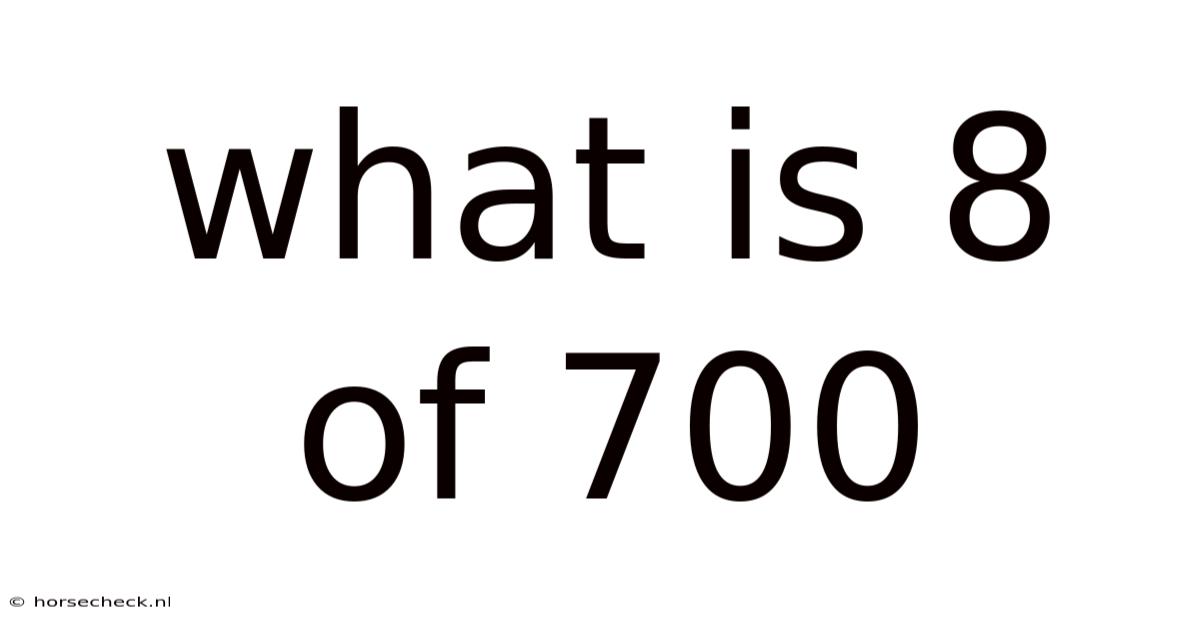What Is 8 Of 700
horsecheck
Sep 23, 2025 · 4 min read

Table of Contents
What is 8/700? Understanding Fractions and Their Simplification
This article explores the question "What is 8/700?" We'll delve into the world of fractions, providing a comprehensive understanding of how to simplify this fraction, its decimal equivalent, and its practical applications. This will equip you with the tools to tackle similar fraction problems with confidence. Understanding fractions is fundamental to various fields, from basic arithmetic to advanced mathematics, science, and even everyday life scenarios like cooking and measuring.
Introduction to Fractions
A fraction represents a part of a whole. It's written as a ratio of two numbers: the numerator (the top number) and the denominator (the bottom number). The numerator indicates how many parts you have, while the denominator indicates how many equal parts the whole is divided into. In the fraction 8/700, 8 is the numerator and 700 is the denominator. This means we have 8 parts out of a total of 700 equal parts.
Simplifying the Fraction 8/700
The fraction 8/700 isn't in its simplest form. Simplifying a fraction means reducing it to its lowest terms by finding the greatest common divisor (GCD) of the numerator and denominator and dividing both by it. The GCD is the largest number that divides both the numerator and denominator without leaving a remainder.
Let's find the GCD of 8 and 700. We can use several methods:
-
Listing Factors: List all the factors of 8 (1, 2, 4, 8) and 700 (1, 2, 4, 5, 7, 10, 14, 20, 25, 28, 35, 50, 70, 100, 140, 175, 350, 700). The greatest common factor is 4.
-
Prime Factorization: Break down both numbers into their prime factors.
- 8 = 2 x 2 x 2 = 2³
- 700 = 2 x 2 x 5 x 5 x 7 = 2² x 5² x 7
The common prime factors are two 2's (2²), so the GCD is 2 x 2 = 4.
Now, we divide both the numerator and denominator by the GCD (4):
8 ÷ 4 = 2 700 ÷ 4 = 175
Therefore, the simplified fraction is 2/175. This is the simplest form because 2 and 175 share no common factors other than 1.
Converting the Fraction to a Decimal
To convert the fraction 8/700 (or its simplified form 2/175) to a decimal, we perform division:
8 ÷ 700 = 0.01142857...
2 ÷ 175 = 0.01142857...
As you can see, both fractions result in the same decimal value. The decimal representation is a non-terminating, repeating decimal. This means the digits after the decimal point continue infinitely, with a repeating pattern (142857). For practical purposes, you might round the decimal to a specific number of decimal places, depending on the required level of accuracy. For example, rounded to four decimal places, it would be 0.0114.
Practical Applications and Real-World Examples
Understanding fractions and their decimal equivalents is crucial in many real-world situations. Here are a few examples:
-
Cooking and Baking: Recipes often require fractions of ingredients. For instance, a recipe might call for 2/3 cup of sugar or 1/4 teaspoon of salt. Understanding fractions is vital for accurate measurements.
-
Measurement and Engineering: In construction, engineering, and other fields, precise measurements are essential. Fractions are frequently used to represent dimensions and tolerances.
-
Finance: Fractions are used extensively in finance, particularly when dealing with percentages, interest rates, and stock prices.
-
Data Analysis and Statistics: Fractions and their decimal equivalents play a significant role in data analysis and statistical calculations.
Further Exploration: Percentage Representation
We can also express the fraction 8/700 (or 2/175) as a percentage. To do this, we convert the fraction to a decimal and then multiply by 100%:
0.01142857... x 100% ≈ 1.14%
This means that 8/700 represents approximately 1.14% of the whole.
Frequently Asked Questions (FAQ)
-
Q: Why is simplifying fractions important?
A: Simplifying fractions makes them easier to understand and work with. It also makes calculations more efficient and reduces the possibility of errors.
-
Q: What if I can't find the GCD easily?
A: You can always use the prime factorization method, which is a reliable way to find the GCD of any two numbers.
-
Q: How many decimal places should I round to?
A: The number of decimal places you round to depends on the context and the required level of accuracy. In some cases, two or three decimal places might suffice, while in others, you may need more.
-
Q: Are there other ways to express fractions?
A: Yes, fractions can also be expressed as decimals, percentages, and ratios. The best representation depends on the specific application.
Conclusion
Understanding fractions is a fundamental skill with broad applications across many disciplines. The fraction 8/700, when simplified, becomes 2/175, which is approximately 0.0114 or 1.14%. Learning how to simplify fractions, convert them to decimals, and understand their practical applications empowers you to solve problems effectively and confidently in various contexts, from everyday tasks to more complex mathematical or scientific endeavors. Remember, mastering fractions builds a solid foundation for more advanced mathematical concepts. Keep practicing, and you'll soon become proficient in working with fractions of all kinds.
Latest Posts
Latest Posts
-
Gcf Of 15 And 16
Sep 23, 2025
-
250 Degrees Celsius In Fahrenheit
Sep 23, 2025
-
43 500 As A Decimal
Sep 23, 2025
-
Rewrite 17777 As A Fraction
Sep 23, 2025
-
3 2 Divided By 3
Sep 23, 2025
Related Post
Thank you for visiting our website which covers about What Is 8 Of 700 . We hope the information provided has been useful to you. Feel free to contact us if you have any questions or need further assistance. See you next time and don't miss to bookmark.